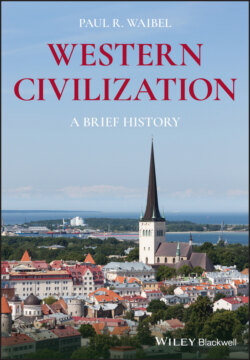Читать книгу Western Civilization - Paul R. Waibel - Страница 58
Rise of Islam
ОглавлениеAt the beginning of the seventh century, the Arabian Peninsula was a vast desert with a few cities here and there along its coasts. The cities were trading centers for luxury goods from the Indian Ocean regions that were carried by caravans across the desert to the urban centers along the coast of the Mediterranean Sea. The desert regions were occupied by Bedouins, nomadic Arab tribes that herded sheep and goats, and raided the caravans and coastal cities to supplement their pastoral lifestyle. Religiously, the Arabs were influenced by Christianity, Judaism, and Zoroastrianism (from Persia). The Bedouins remained largely pagan, worshipping a variety of tribal gods.
The city of Mecca, located 43 miles (70 km) inland on the eastern coast of the Red Sea, was a place of worship of the various pagan gods, and therefore “sacred” to the Bedouins and city dwellers alike. By the beginning of the seventh century, Mecca was a trading center, especially for the lucrative spice trade. A cube‐shaped granite structure called the Kaaba is located in Mecca. It was a worship center for the various pagan deities. Inside the Kaaba was the Black Stone, that all of the tribes believed was sent to earth by Allah, the most powerful of the gods.
Muhammad was born in Mecca, probably in 570, and died in Medina in 632. When he was 40 years old, he claimed that the angel Gabriel visited him and delivered to him the first of an unknown number of revelations from Allah. They were later, years after Muhammad's death, collected and became the Islamic holy book, the Quran (or Koran).
Muhammad began preaching a radical form of monotheism to the residents of Mecca in about the year 610. The Meccans did not welcome his message. In 622, he was forced to leave the city. He went to Medina, where his preaching began to enjoy some success. The flight to Medina and the time spent there is referred to as the Hegira.
From the beginning in 622, Muhammad spread his new religion of Islam by military conquest. After each victory, the men were executed and the women and children were either taken as booty or sold into slavery. By the end of 630, Mecca and all of the Arabian Peninsula was ruled by Muhammad. The first encounters between Christian (Byzantine) and Muslim armies occurred during the 630's. Both Antioch and Jerusalem were conquered in 637. Muslim armies spread Islam rapidly west and east of the Arab Peninsula. By 732, they conquered North Africa, crossed into Spain, and continued across the Pyrenees Mountains until halted by the Franks at the Battle of Tours (732). By 750, they expanded eastward to India and as far as the Talas River Valley in Central Asia. A major battle was fought in July, 751, in the Talas River Valley between an Arab‐Persian army and a Chinese army of the Tang dynasty. The battle is significant because the Muslim victory halted the westward expansion of the Chinese.
Islamic culture impacted European culture in a variety of ways, most often through Spain, Sicily, and southern Italy where there was close contact over a long period of time. Understandably, there was an unconscious assimilation in such areas as food, vocabulary, the fine arts, and architecture. Much more important was the importation of the vast quantity of classical literature. Most important were the works of Aristotle and the commentaries on his works by Middle Eastern scholars. Aristotle became “the philosopher” of the Middle Ages, and the subsequent challenge to his influence helped to spark the Scientific Revolution in the last half of the sixteenth century. We shall return to this part of the story in the next three chapters.
